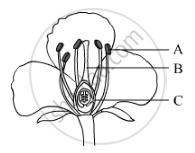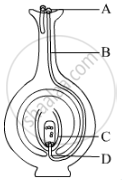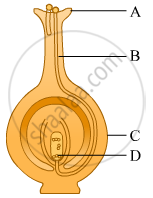Advertisements
Advertisements
प्रश्न
What is the structural unit of sexual reproduction in plant?
उत्तर
Flower is the structural unit of the sexual reproduction in plant.
APPEARS IN
संबंधित प्रश्न
Name the parts labelled as A, B, C and D in the diagram given below:-

Name the parts A, B and C shown in the following diagram and state one function of each.

Name the parts labelled as A, B, C and D in the diagram given below:

A flower may have either male or female reproductive parts. Such a flower is called ______.
State the name of the functional unit concerned with sexual reproduction.
What is the name of female part of a flower?
Fill in the following blank with suitable word :
Ovules contain ......... gametes of a plant.
Explain the terms 'self pollination'
In a bisexual flower, inspite of the young stamens being removed artificially, the flower produces fruit. Explain.
In what ways is fertilisation in a plant different from fertilisation in a human?
State whether the following statement is true (T) or false (F):
Stamens make egg cells.
State whether the following statement is true (T) or false (F):
Flowers which possess stamens and carpel are called unisexual.
Mention the function of Flower.
What part is played by stamens and carpels in reproduction?
Give one example each of unisexual and bisexual flowers. Differentiate between the two types of pollination that occur in flowers. What happens when a pollen lands on a suitable stigma? Write about the events that occur till the seed formation in the ovary.
Draw a diagram of the longitudinal section of a flower exhibiting germination of pollen on stigma and label (i) ovary, (ii) male germ-cell, (iii) female germ-cell and (iv) ovule on it.
Identify A, B, C and D in the given diagram and write their names.
Explain the process of fertilisation in flowers.
A student is asked to study the different parts of an embryo of pea seeds. Given below are the essential steps for the experiment :
(I) Soak the pea seeds in plain water and keep them overnight.
(II) Cut open the soaked seed and observe its different parts.
(III) Take some pea seeds in a petri dish.
(IV) Drain the excess water. Cover the seeds with a wet cotton cloth and leave them as it is for a day.
The correct sequence of these steps is
(A) III, I, IV, II
(B) III, IV, I, II
(C) III, I, II, IV
(D) III, II, I, IV
“Cell division is a type of reproduction in unicellular organism.” Justify.
What is phototropism?
Which of the following is not an unisexual flower?
a) Coconut
b) Papaya
c) Gulmohor
d) Maize
What is pollination? Mention its types.
Answer the following question.
How does suitable pollination lead to fertilization?
A student is observing the temporary mount of a leaf peel under a microscope. Draw a labelled diagram of the structure of stomata as seen under the microscope
Observe the figure below. Write functions of the labelled parts.

The male reproductive part of a flower is ______.
Antipodal cells are present towards the ______ in an anatropous ovule.
What would be the number of chromosomes in the cells of the aleurone layer in a plant species with 8 chromosomes in its synergids?
The process of release of eggs from the ovary is called ______
In human beings, fertilization occurs in the ______
Pollen grains are produced by ______
Double fertilization is exhibited by ______
What is the function of calyx?
What is puberty?
Type of sexual reproduction is ______.
Given below is a diagram of a germinating seed. Label the parts that:
- gives rise to future shoot.
- gives rise to future root system.
- stores food.

State the post-fertilisation changes that lead to fruit formation in plants.
